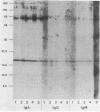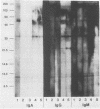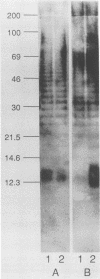Abstract
Tularemia is a disease caused by the facultative intracellular bacterium Francisella tularensis. We evaluated a new lot of live F. tularensis vaccine for its immunogenicity in human volunteers. Scarification vaccination induced humoral and cell-mediated immune responses. Indications of a positive immune response after vaccination included an increase in specific antibody levels, which were measured by enzyme-linked immunosorbent and immunoblot assays, and the ability of peripheral blood lymphocytes to respond to whole F. tularensis bacteria as recall antigens. Vaccination caused a significant rise (P less than 0.05) in immunoglobulin A (IgA), IgG, and IgM titers. Lymphocyte stimulation indices were significantly increased (P less than 0.01) in vaccinees 14 days after vaccination. These data verify that this new lot of live F. tularensis vaccine is immunogenic.
Full text
PDF








Images in this article
Selected References
These references are in PubMed. This may not be the complete list of references from this article.
- Bevanger L., Maeland J. A., Naess A. I. Agglutinins and antibodies to Francisella tularensis outer membrane antigens in the early diagnosis of disease during an outbreak of tularemia. J Clin Microbiol. 1988 Mar;26(3):433–437. doi: 10.1128/jcm.26.3.433-437.1988. [DOI] [PMC free article] [PubMed] [Google Scholar]
- Blondeau J. M., Williams J. C., Marrie T. J. The immune response to phase I and phase II Coxiella burnetii antigens as measured by western immunoblotting. Ann N Y Acad Sci. 1990;590:187–202. doi: 10.1111/j.1749-6632.1990.tb42220.x. [DOI] [PubMed] [Google Scholar]
- Burke D. S. Immunization against tularemia: analysis of the effectiveness of live Francisella tularensis vaccine in prevention of laboratory-acquired tularemia. J Infect Dis. 1977 Jan;135(1):55–60. doi: 10.1093/infdis/135.1.55. [DOI] [PubMed] [Google Scholar]
- Hambleton P., Evans C. G., Hood A. M., Strange R. E. Vaccine potencies of the live vaccine strain of Francisella tularensis and isolated bacterial components. Br J Exp Pathol. 1974 Aug;55(4):363–373. [PMC free article] [PubMed] [Google Scholar]
- Hornick R. B., Eigelsbach H. T. Aerogenic immunization of man with live Tularemia vaccine. Bacteriol Rev. 1966 Sep;30(3):532–538. doi: 10.1128/br.30.3.532-538.1966. [DOI] [PMC free article] [PubMed] [Google Scholar]
- KADULL P. J., REAMES H. R., CORIELL L. L., FOSHAY L. Studies on tularemia. V. Immunization of man. J Immunol. 1950 Oct;65(4):425–435. [PubMed] [Google Scholar]
- Koskela P., Herva E. Cell-mediated and humoral immunity induced by a live Francisella tularensis vaccine. Infect Immun. 1982 Jun;36(3):983–989. doi: 10.1128/iai.36.3.983-989.1982. [DOI] [PMC free article] [PubMed] [Google Scholar]
- Kostiala A. A., McGregor D. D., Logie P. S. Tularaemia in the rat. I. The cellular basis on host resistance to infection. Immunology. 1975 May;28(5):855–869. [PMC free article] [PubMed] [Google Scholar]
- Markwell M. A. A new solid-state reagent to iodinate proteins. I. Conditions for the efficient labeling of antiserum. Anal Biochem. 1982 Sep 15;125(2):427–432. doi: 10.1016/0003-2697(82)90025-2. [DOI] [PubMed] [Google Scholar]
- McCrumb F. R. AEROSOL INFECTION OF MAN WITH PASTEURELLA TULARENSIS. Bacteriol Rev. 1961 Sep;25(3):262–267. doi: 10.1128/br.25.3.262-267.1961. [DOI] [PMC free article] [PubMed] [Google Scholar]
- SASLAW S., EIGELSBACH H. T., PRIOR J. A., WILSON H. E., CARHART S. Tularemia vaccine study. II. Respiratory challenge. Arch Intern Med. 1961 May;107:702–714. doi: 10.1001/archinte.1961.03620050068007. [DOI] [PubMed] [Google Scholar]
- SASLAW S., EIGELSBACH H. T., WILSON H. E., PRIOR J. A., CARHART S. Tularemia vaccine study. I. Intracutaneous challenge. Arch Intern Med. 1961 May;107:689–701. doi: 10.1001/archinte.1961.03620050055006. [DOI] [PubMed] [Google Scholar]
- Sandström G., Löfgren S., Tärnvik A. A capsule-deficient mutant of Francisella tularensis LVS exhibits enhanced sensitivity to killing by serum but diminished sensitivity to killing by polymorphonuclear leukocytes. Infect Immun. 1988 May;56(5):1194–1202. doi: 10.1128/iai.56.5.1194-1202.1988. [DOI] [PMC free article] [PubMed] [Google Scholar]
- Sandström G., Tärnvik A., Wolf-Watz H. Immunospecific T-lymphocyte stimulation by membrane proteins from Francisella tularensis. J Clin Microbiol. 1987 Apr;25(4):641–644. doi: 10.1128/jcm.25.4.641-644.1987. [DOI] [PMC free article] [PubMed] [Google Scholar]
- Sjöstedt A., Tärnvik A., Sandström G. The T-cell-stimulating 17-kilodalton protein of Francisella tularensis LVS is a lipoprotein. Infect Immun. 1991 Sep;59(9):3163–3168. doi: 10.1128/iai.59.9.3163-3168.1991. [DOI] [PMC free article] [PubMed] [Google Scholar]
- Syrjälä H., Herva E., Ilonen J., Saukkonen K., Salminen A. A whole-blood lymphocyte stimulation test for the diagnosis of human tularemia. J Infect Dis. 1984 Dec;150(6):912–915. doi: 10.1093/infdis/150.6.912. [DOI] [PubMed] [Google Scholar]
- Syrjälä H., Koskela P., Ripatti T., Salminen A., Herva E. Agglutination and ELISA methods in the diagnosis of tularemia in different clinical forms and severities of the disease. J Infect Dis. 1986 Jan;153(1):142–145. doi: 10.1093/infdis/153.1.142. [DOI] [PubMed] [Google Scholar]
- TIGERTT W. D. Soviet viable Pasteurella tularensis vaccines. A review of selected articles. Bacteriol Rev. 1962 Sep;26:354–373. doi: 10.1128/br.26.3.354-373.1962. [DOI] [PMC free article] [PubMed] [Google Scholar]
- Tärnvik A., Sandström G., Löfgren S. Time of lymphocyte response after onset of tularemia and after tularemia vaccination. J Clin Microbiol. 1979 Dec;10(6):854–860. doi: 10.1128/jcm.10.6.854-860.1979. [DOI] [PMC free article] [PubMed] [Google Scholar]
- VAN METRE T. E., Jr, KADULL P. J. Laboratory-acquired tularemia in vaccinated individuals: a report of 62 cases. Ann Intern Med. 1959 Mar;50(3):621–632. doi: 10.7326/0003-4819-50-3-621. [DOI] [PubMed] [Google Scholar]
- Williams J. C., Damrow T. A., Waag D. M., Amano K. Characterization of a phase I Coxiella burnetii chloroform-methanol residue vaccine that induces active immunity against Q fever in C57BL/10 ScN mice. Infect Immun. 1986 Mar;51(3):851–858. doi: 10.1128/iai.51.3.851-858.1986. [DOI] [PMC free article] [PubMed] [Google Scholar]
- Williams J. C., Thomas L. A., Peacock M. G. Identification of phase-specific antigenic fractions of Coxiella burnetti by enzyme-linked immunosorbent assay. J Clin Microbiol. 1986 Dec;24(6):929–934. doi: 10.1128/jcm.24.6.929-934.1986. [DOI] [PMC free article] [PubMed] [Google Scholar]





